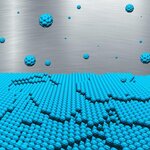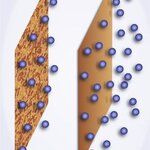Applied Physics

Imagine a car that can't get dirty or a business in Ferguson, Missouri that can't be graffiti'ed by unhinged protesters.
It might be possible with a new class of highly fluorinated super-repellent polymer called a “fluoropore”, which mimics the natural ability of lotus plants and cabbage leaves to make water droplets simply roll away - but for oils too. This lotus effect has been used for producing rough surfaces with special chemical properties. “However, this trick does not work for oils – the lotus plant repels water, but no oil,” says Dr.-Ing. Bastian Rapp of the KIT Institute of…

How is this for the ultimate miniaturization of energy storage: A new tiny nanopore includes all the components of a battery though it is just is a tiny hole in a ceramic sheet that holds an electrolyte to carry the electrical charge between nanotube electrodes at either end - and 1,000,000,000 can fit in the size of a postage stamp.
The existing device is a test but the nano-sized battery performs well - and it can be fully charged in 12 minutes, thousands of times.
One of the reasons the researchers think this unit is so successful is because each nanopore is shaped just like…

The van der Waals force, named after Dutch chemist Johannes Diderik van der Waals, is the total forces between molecules not due due to covalent bonds. The famous sticking power of the geckos is thanks to the van der Waals force.
Although it was discovered in the 19th century, it is still difficult to quantify when predicting the behavior of solids, liquids, and molecules because precise measurements were only possible for single atoms. That won't do for understanding biomolecules and proteins. They are also responsible for the functioning of certain adhesives and are the reason…

Physicists have developed a new cooling technique for mechanical quantum systems by using an ultracold atomic gas, cooling a membrane down to less than 1 degree above absolute zero.
Ultracold atomic gases are among the coldest objects in existence. Laser beams can be used to trap atoms inside a vacuum chamber and slow down their motion to a crawl, reaching temperatures of less than 1 millionth of a degree above absolute zero - the temperature at which all motion stops.
At such low temperatures, atoms obey the laws of quantum physics: they move around like small wave packets and can be in a…
What’s a relay? You’ve probably seen a relay race where one runner hands off a baton to another runner. Similarly, an electronic relay hands off control from one circuit to another. A relay is a very simple device consisting of an electromagnet, an armature (a switch that closes when attracted by the electromagnet), and a spring that is connected to the armature.
(Diagram inspired by: http://electronics.howstuffworks.com/relay1.htm)
In Figure 1 (above), there are two circuits. The first circuit is a battery (3 volts), a switch and an electromagnet. The second circuit is a battery (6…

In my previous article about the Kano Computer, I demonstrated how to use MIT’s Scratch graphical programming language on the Kano to flash an LED (the “Hello World!” program of hardware hacking). In this article, I’ll again demonstrate how to flash an LED, but using a special variable in Scratch called “MotorA”. Scratch automatically handles all of the programming for MotorA to produce a “pulse width modulation” (PWM) signal on Pin 11 of the Raspberry Pi. For a primer on pulse width modulation, see this article. I’ll show you how to write a simple program to increase and decrease the…

"In space no one can hear you scream" was the tagline for the movie Alien. I finally created a Twitter account, but in Twitter, if you have no followers, no one can read your tweets. You are welcome to follow me on Twitter: @SteveSchuler20
Picture source.

Researchers have witnessed how football-shaped carbon molecules known as
buckyballs
arrange themselves into ultra-smooth layers, all in real time, and by piecing that together with theoretical simulations, the investigators believe they can advance the field of plastic electronics.
Buckyballs are spherical molecules which consist of 60 carbon atoms (C60), named such because they are reminiscent of American architect Richard Buckminster Fuller's geodesic domes. With their structure of alternating pentagons and hexagons, they also resemble tiny molecular footballs.
Using DESY's X-ray…

It's common sense that if you have ne mess and add another mess, you have created an even bigger mess.
But in arcane statistics, economics and social science, a bigger mess can lead to more order - a concept known as antifragility.
In a paper published in The Journal of Chemical Physics, researchers found a counterintuitive interplay between two different types of disorder. One is thermodynamic disorder, or entropy. The other is the structural disorder—defects in an idealized system that can change its properties.
Chaos is not necessarily bad for us if we know how to counteract it…

Thermodiffusion is when a temperature difference establishes a concentration difference in a mixture. Two recent studies build on recent experimental results from the IVIDIL (Influence Vibration on Diffusion in Liquids) research project performed on the International Space Station under microgravity to avoid motion in liquids.
Using a mathematical model, the authors set out to identify how vibrations applied to a binary liquid mixture change the temperature and concentration fields over a long time scale, which is important for studying multi-component mixtures in orbit. By extending the…